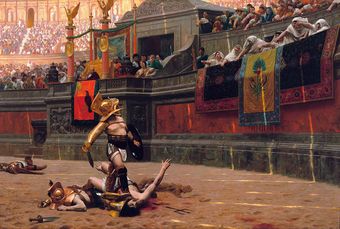التصويت بالإبهام
التصويت بالإبهام Pollice verso أو verso pollice هو عبارة لاتينية، تعني "بإدارة الإبهام (لأعلى أو لأسفل)"، التي تُستخدم في سياق قتال المجالدين. وتشير إلى ايماءة اليد أو إشارة الإبهام التي كان يستخدمها الجمهور الروماني القديم للتصويت على مصير المجالد المهزوم: فإدارة الإبهام لأعلى تعني إبقائه حياً، وإدارة الإبهام لأسفل تعني التصويت لقتله.
نوع الايماءة الموصوف بالتعبير pollice verso ومعناه هو موضع الكثير من الجدل الأكاديمي.
. . . . . . . . . . . . . . . . . . . . . . . . . . . . . . . . . . . . . . . . . . . . . . . . . . . . . . . . . . . . . . . . . . . . . . . . . . . . . . . . . . . . . . . . . . . . . . . . . . . . . . . . . . . . . . . . . . . . . . . . . . . . . . . . . . . . . . . . . . . . . . . . . . . . . . . . . . . . . . . . . . . . . . . .
روما القديمة
The type of gesture described by the phrase pollice verso is unclear. From historical, archaeological and literary records it is uncertain whether the thumb was turned up, turned down, held horizontally, or concealed inside the hand to indicate positive or negative opinions.[1][2][3]
Juvenal in the Satires writes:
Quondam hi cornicines et municipalis harenae |
These men once were horn-blowers, who went the round of every provincial show, |
في الثقافة الشعبية
The notion of the pollice verso thumb signal was brought to popular attention by an 1872 painting by French history painter Jean-Léon Gérôme titled Pollice Verso (usually translated into English as Thumbs Down). It is a large canvas that depicts the Vestal Virgins signifying to a murmillo that they decree death on a fallen gladiator in the arena. The picture was purchased from Gérôme by U.S. department-store magnate Alexander Turney Stewart, who exhibited it in New York City, and it is now in the Phoenix Art Museum in Arizona.
The painting had a strong influence on the film Gladiator. The producers showed director Ridley Scott a reproduction of the painting before he read the script: "That image spoke to me of the Roman Empire in all its glory and wickedness. I knew right then and there I was hooked", commented Scott.[6]
Pollice Verso is also the title of a controversial 1904 drawing of the Crucifixion by Australian artist Norman Lindsay.[7]
المراجع
- ^ James Grout: The Gladiator and the Thumb, part of the Encyclopædia Romana
- ^ Desmond Morris, Peter Collett, Peter Marsh and Marie O'Shaughnessy, 1979 Webified by Bernd Wechner: Gestures: Their Origin and Meanings, The Thumb Up
- ^ "DID THE ROMANS TURN THUMBS DOWN ON GLADIATORS?". www.news.ku.edu.
- ^ Juvenal, Satirae 3.34-37
- ^ Juvenal Satires, translated by George Gilbert Ramsay (1839–1921)
- ^ "Pollice Verso (Thumbs Down) - Jean-Léon Gérôme - 1872 - Phoenix Art Museum". egallery.phxart.org.
- ^ "National Gallery of Australia".
للاستزادة
- Anthony Philip Corbeill – "Thumbs in Ancient Rome: pollex as Index" in Memoirs of the American Academy in Rome 42 (1997) pp. 61–81.
- Anthony Corbeill – Nature Embodied: Gesture in Ancient Rome (Princeton University Press, 2004) 978-0-691-07494-8
- Desmond Morris – Gestures: Their Origin and Distribution (1979)
- "Top 10 Myths About the Romans" at listverse.com (5 May 2008)
وصلات خارجية
- "Pollice Verso", article by Edwin Post in American Journal of Philology, Vol. 13, No. 2 (1892), pp. 213–225, online at LacusCurtius
- "The Gladiator and the Thumb"
- "Pollice Verso" at Phoenix Art Museum
